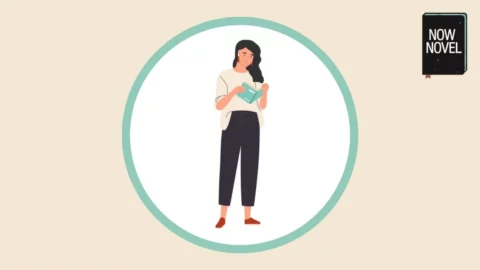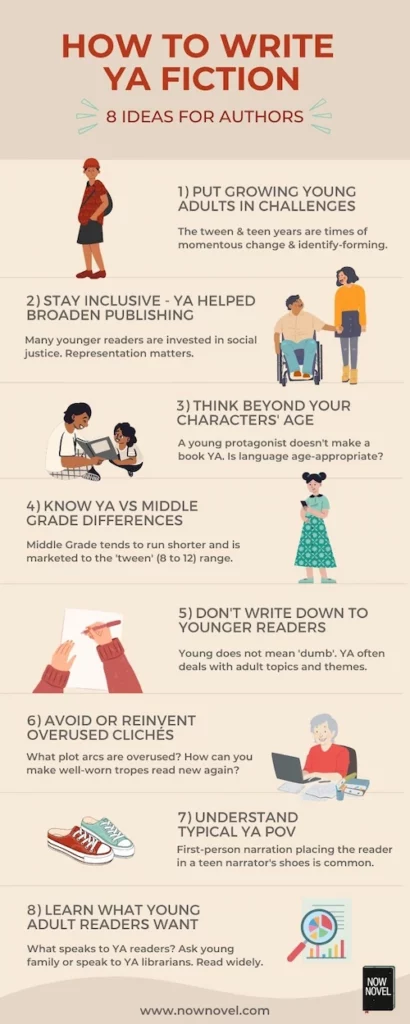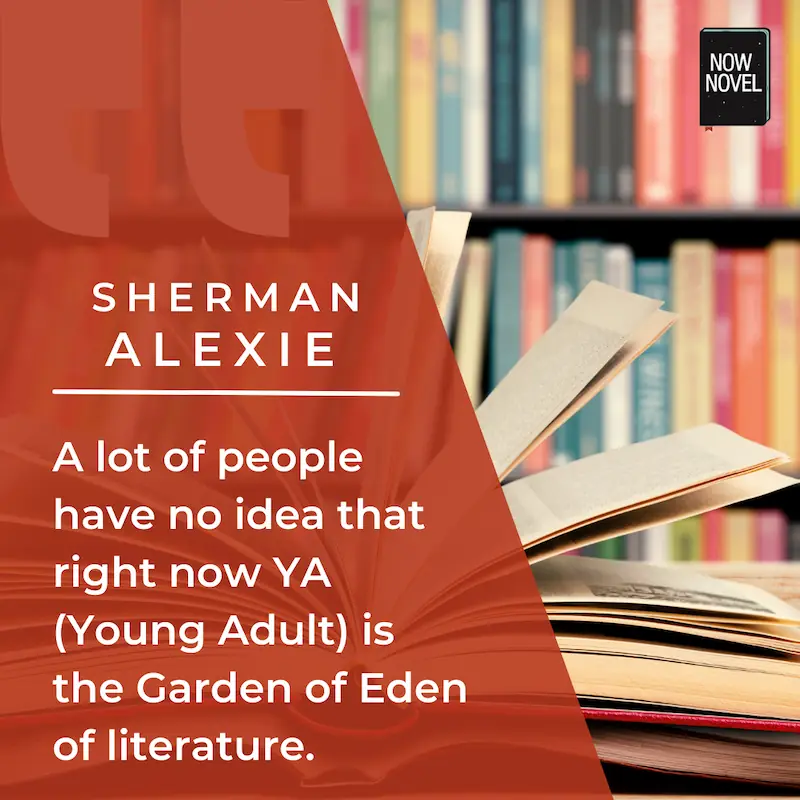Young adult fiction, also known as YA, is a very popular fiction marketing category (rather than genre). Read this detailed guide for info on what makes a book YA, what YA readers look for, and what to avoid in writing for a young adult audience:
What makes a book YA?
Young adult fiction is read by readers (and YA writers) of all ages. A YA book typically:
- Appeals to readers between the ages of 12 and 18 (and is matched to reading norms of this age range in terms of complexity)
- Features a protagonist around 14 to 18 years old
- Explores themes, subjects and challenging issues typical of this age group (moving towards independence, balancing freedom and responsibility, developing identity and extra-familial social bonds)
- Blurs genre boundaries (hence YA fantasy, paranormal and other genre/category hybrids)
YA is a category, not a genre
YA is a marketing and age-based category that aids bookstores, librarians, teachers and parents in choosing books, but a YA book can belong to any genre. That means a YA novel might be fantasy, science fiction, mystery, romance, horror, thriller or mainstream.
Consider the popular YA novels The Giver by Lois Lowry (1993), a young adult dystopian novel, or the The Fault in Our Stars (2012) by John Green with its frank, touching exploration of teen cancer.
These are very different types of books, yet they are still YA fiction: the same reader might enjoy reading them as they are similar in terms of protagonists’ ages and the simplicity of language used.
Some YA writers cite the freedom to move more freely between genres as one aspect of writing YA fiction they love. Says author and YA librarian MK England:
There’s no shame. Read romance, read sci fi, read literary, read horror—the culture of judgment just doesn’t exist in the YA world to the same degree it does in the adult world.
MK England, ‘Why I write YA’, March 20, 2017
How to write YA fiction
- Put growing young adults in challenging situations
- Stay inclusive – YA helped broaden publishing
- Think beyond how old YA characters are
- Know YA vs Middle Grade differences
- Don’t write down to younger readers
- Avoid or reinvent overused YA clichés
- Understand typical YA POV
- Learn what Young Adult audiences want
Put growing young adults in challenging situations
Change is the lifeblood of stories. It’s the origin and end-result of conflict and is particularly marked crossing from childhood to (young) adulthood.
Many young adult novels deal frankly with ‘adult’ topics such as sex, romantic relationships and issues such as drug use or difficult parental relationships, because the boundary-pushing teenaged years are when many young people encounter said topics for the first time.
Thumbelina by Andrea Koenig (1999) for example deals with topics such as teen pregnancy and foster care.
As YA author England says in ‘Why I Write YA’:
Teenagers are at the greatest point of change in life, and that makes for fascinating characters to explore. Throw someone who is growing and changing and forming their identity into challenging circumstances and watch the magic happen. Many adults are quite set in their ways. Teens are more likely to be adaptable, fierce, open-minded.
England, ‘Why I Write YA’
Using conflict and change agents in YA novels
Challenging situations encountered during teenage years may include:
- Navigating a first big love
- Tension between desiring independence and still being dependent upon guardians
- Issues at school (bullying, challenging friendships, social dynamics, academic performance)
- Identify and the impact of growing self-awareness and individuation (such as prejudice around race and sexuality)
What challenges will bring internal and external conflict to your own YA characters’ lives?
Stay inclusive – YA helped broaden publishing
Many young adults and readers in their 20s (Generation Z and so-called ‘zillenialls’) are strongly invested in social justice.
This is part of why YA has driven the broadening of publishing, the championing of more diverse voices.
It’s common to find articles championing YA novels that include BIPOC (black, indigenous and people of color) characters, those who are differently abled, or LGBTQIA+ (lesbian, gay, bisexual, trans, queer, intersex, asexual and other) meaningfully. Read a detailed blog on how to avoid stereotypes when writing LGBTIQ+ characters.
‘Cancelling’ authors who exclude, misrepresent or tokenize marginalized communities is also a common social media phenomenon. J.K. Rowling’s commenting on trans rights and issues is an example of how badly it can go wrong when one does not listen around sensitive issues.
Why inclusivity in YA matters (and in other categories too)
There are multiple reasons to be inclusive in YA:
- Representation matters – young adults, like people of all ages, like to see themselves in the characters in a story and to be able to relate rather than be ‘othered’ or excluded
- Marginal does not equal minority – not appealing to a broad swathe of the population by never representing (or misrepresenting) a specific demographic could mean less sales to this demographic and their allies at best (and negative press at worst)
YA author Nicola Yoon says, when asked about diversity in YA:
I think it’s very important! […] We tell stories about ourselves. It’s how we know who we are. And if you tell the same story to a kid, if you tell them that “all gay kids are, whatever” or “all black kids are this other thing” then they’re going to start to internalize and believe that. We have to tell a variety of stories, and we have to put a variety of people into stories.
Nicola Yoon, ‘Interview with Nicola Yoon on love, representation, and writing outside the box’, Books-A-Million
The flipside of this to avoid is ‘tokenism’, having a single character who shoehorns in X identity (for example the trope of the ‘gay best friend’).
Inclusive representation in books shows people in all their individuality and heterogenous personality, values, and more.
Think beyond how old YA characters are
A Young Adult book has a young person as a protagonist, but that in itself is not enough to make your book YA.
Examples of books that are not aimed at young readers despite having a young protagonist include two of Donna Tartt’s novels, The Little Friend (2002) and The Goldfinch (2013) and Emma Donoghue’s Room (2010).
YA novels tend to be immersed in the young person’s point of view. The reader is invited to identify fully with the protagonist.
Language is an important aspect, as award-winning YA author and Now Novel writing coach Nerine Dorman shared in our webinar on writing YA.
YA’s language is accessible and easy to understand. You can use an online language checker tool such as Hemingway to check how your writing compares to age norms.
Know YA vs Middle Grade differences
Given the close age between Young Adult and Middle Grade readers, it’s easy to mix up these book categories. In writing YA vs Middle Grade, remember these categories differ most in length, age reading norms and tone/subjects.
Even though middle grade fiction may have older readers just as YA does, there are a few significant difference between the two:
- Middle grade protagonists tend to be around nine to twelve years old – the ‘tween’ years – so these books are aimed at a slightly younger demographic. YA protagonists are generally mid- to older teens.
- Middle-grade books are often shorter with a word count around 20,000 to 50,000 words while YA books are around 50,000 to 70,000 words, though some run well upwards of this.
- Middle-grade books tend to be less complex in general and deal with fewer controversial issues.
When asked about writing dystopian fiction for middle-graders, Maze Runner author James Dashner told Publishers Weekly:
I really love middle-grade. Middle-grade books have a little more of a magical, light-hearted feel. You can be a little bit more quirky, you can have a little more humor. It doesn’t get so dark and deep.
James Dashner, ‘Q&A with James Dashner’, Publishers Weekly, August 2nd 2012.
Don’t write down to younger readers
If there’s one thing younger people (and readers) dislike it’s being talked down to, treated like a child (especially when they are 13 going on 30!).
This is great advice courtesy of Young Adult author Seth Fishman, who says:
‘Young Adult’ does not mean stupid. It doesn’t mean ignorant. The major constrictions on YA are age of protagonist and cursing and violent/sexual content. Depending on the book, the latter two constraints are already becoming commonplace. So basically, YA really just means a teen protagonist. […] When you write for teens, don’t patronize or condescend.
Seth Fishman, ‘How to Write YA’, Publishers Weekly, February 27 2014.
Some people may assume that because they are shorter or because they are not for adults, YA novels are easier to write, but this is not the case.
In fact, YA novels have a number of requirements that might not apply to adult novels. YA novels must have an economy of language and strong pacing.
Writers cannot assume that they can fall back on plot clichés simply because they may be writing for younger readers. A YA novel requires the same amount of skill as writing for any other audience.
Avoid or reinvent overused YA clichés
There are exceptions to every rule, and if you can reinvent a cliché (or parody it brilliantly), more power to you.
Young Adult clichés from YA fantasy and other young adult genres include:
- The protagonist is the chosen one. This is a time-honoured trope in fantasy fiction, yet almost every other fantasy book uses it.
- The protagonist is an orphan. This is a convenient way of getting parents out of the picture and making a protagonist more vulnerable, but again, it’s been done so often that it has begun to feel tired.
- The protagonist is caught in a love triangle. Readers swooned over Edward and Jacob in the Twilight series and cheered for either Peeta or Gale in The Hunger Games trilogy.
To some readers, the main character caught between two love interests may feel overdone or outmoded (given the increasing normalization of other relationship structures such as polyamory).
Some people love clichés, though – the predictably familiar can also be fun. One Twitter user wrote, ‘I know it’s a trope but you can prize enemies to lovers’ (a familiar YA romance trope) ‘…out of my cold, dead hands.’
What are some of the most frustrating YA novel clichés, in your opinion? Or are there any you secretly hate to love? Let us know in the comments below.
Understand typical YA POV
One thing writers may begin to notice is that the typical YA voice tends to be first person, present-tense, chatty and heavy on dialogue.
This does not mean that all YA novels need to be written in this voice, and indeed, writers might set themselves apart by using a different approach altogether.
But it does provide a hint to the breezy, casual yet intimate manner of narration many YA readers want.
Learn what Young Adult audiences want
If there’s any readership that will not hesitate to leave a cutthroat, GIF-filled Goodreads review takedown, it’s YA.
Fortunately, you can learn a lot from hanging around YA forum discussions such as this Goodreads poll about the YA tropes readers are sick of.
Read often and widely within the Young Adult category and within subgenres relevant to your subject matter for this age group. Popular genres within YA include:
- Fantasy
- Romance
- Science fiction
- Social issues
- Art, music and photography
- Sports
- Religion and spirituality
This will not only give you an idea of what’s current and trending but what’s oversaturated in the market, too. It will help you determine things such as:
- How to approach more adult topics in YA such as sex
- How much profanity is too much (and which curse words get more of a pass)
- Which books would make great comp titles to mention when querying
Tips to get to know your Young Adult audience
Many YA authors (like MK England in the article linked above) have direct connection to younger readers. Some are parents. Some are librarians, teachers or others who interact with children in the YA target audience range due to their vocation.
To write convincingly for younger readers in the YA age range, spend time with younger readers in your family or friend circle. Ask things like:
- What are you reading (at home or in school)?
- What do you like most about the story?
- Who are your favorite writers? Why?
Social platforms that skew younger (e.g. TikTok and Tumblr) are also useful for finding YA conversations and what teen readers love.
From a marketing perspective, remember that many book buyers in the YA category are parents, grandparents or other older friends to teenagers (such as family friends) looking for something suitable. Nerine Dorman raised this in our webinar on how to write YA.
So think about his audience – people who want to encourage young readers – in how you market your YA books too.
What do you love most about YA fiction? What type of YA are you writing? Let us know in the comments.
Join Now Novel for help developing your YA or other stories, from coaching to caring community critique.

BE FIRST TO KNOW
Join 13,000+ subscribers in getting weekly writing tips and how to’s direct.






9 replies on “How to write YA fiction: Detailed guide”
I disagree with the statement that there isn’t much that’s taboo in YA these days. I actually read a book marketed as YA the other day that was brimming with sex/sexual references/sensuality. I went to the comments section on Goodreads and had a difficult time finding a single positive comment. Even if the reader liked the book, they stated they could have done without the sexuality. Leave sex out of the YA books. There’s enough stress and difficulty in our age bracket without encouraging this too.
Thanks for the insight, Cori. Good point that even if writers are doing it, readers aren’t necessarily loving it (i.e. it might not seem taboo from a writer’s perspective but from a reader’s it certainly can be). Are there any particular YA books you’d recommend?
I recommend a book by Jim West called Libellus de Numeros (The Book of Math) that my 11-year-old daughter just finished reading. The story is about Alex, a young precocious girl, who mysteriously gets transported to a strange world where Latin and Math combine in formulas and equations with magical effects. With a cruel council leading the only safe city of its kind in this world, she will have to prove her worth to stay as well as help this city as it is the target for two evil wizards who seek to destroy the city and its ruling council. To help the city and also get back home, she will need the help of the greatest mathematician of all time, Archimedes. In a world where math is magic, Alex wishes she paid more attention in math class.
A Goodread 5-star review said:
“The storyline inspires a hunger for knowledge and a ‘can do’ attitude – a strong message of empowerment for young readers. I’m sure that this book will be interesting to read for both, boys and girls, as well as adult readers. Libellus de Numeros means ‘Book of Numbers’ and it’s a magical textbook in the story. Math and science are wonderfully incorporated into a captivating plot: Latin and math are presented as exciting tools to make ‘magic’ and while Latin is often used as a language of magic the addition of math is definitely a fresh approach.
“The main heroine Alex is a very relatable character for young people, especially girls. I love that she has her flaws and goes through struggles all too familiar to a lot of young people. Alex is an authentic female role model – a very courageous girl, who is not afraid to stand up for herself and others and who is able to learn fast how to use knowledge to her best advantage.
“She can definitely do everything that boys can and I find this to be a very powerful message that is needed in our modern society. Furthermore, it was a pleasure to read through the pages of a well-formatted eBook. Highly recommended!”
Thanks so much for the recommendation, Tamara. Sounds like a fantastic premise and also a great idea for instilling a love for mathematics in this age group. Will definitely look the book up.
I’m always thankful when someone clarifies that YA is a marketing category, and not really a fiction genre. I go crazy when someone just says “I like YA novels”. What, mystery? Urban fantasy? No, don’t tell me, you’re talking dystopian or paranormal romance, aren’t you?!
It’s true. Although I suppose what people might identify as genre characteristics are more stylistic – i.e. age-appropriate style and so forth. There are so many different terms and categories to keep track of.
I never really thought about YA being anything but a genre, but after reading that, everything seemed to click.
I’m guilty of saying I like YA novels, but only to give a general idea of the type of books I’m interested in. I view YA as a category, just as children’s books is a category.
[…] Prominent children’s writers include A. A. Milne, Roald Dahl, Dr. Seuss, Madeleine L’Engle, Diana Wynne Jones, Anne Fine, and Peggy Parish. Here are 10 tips for picture book writers, and here is advice for YA novelists. […]